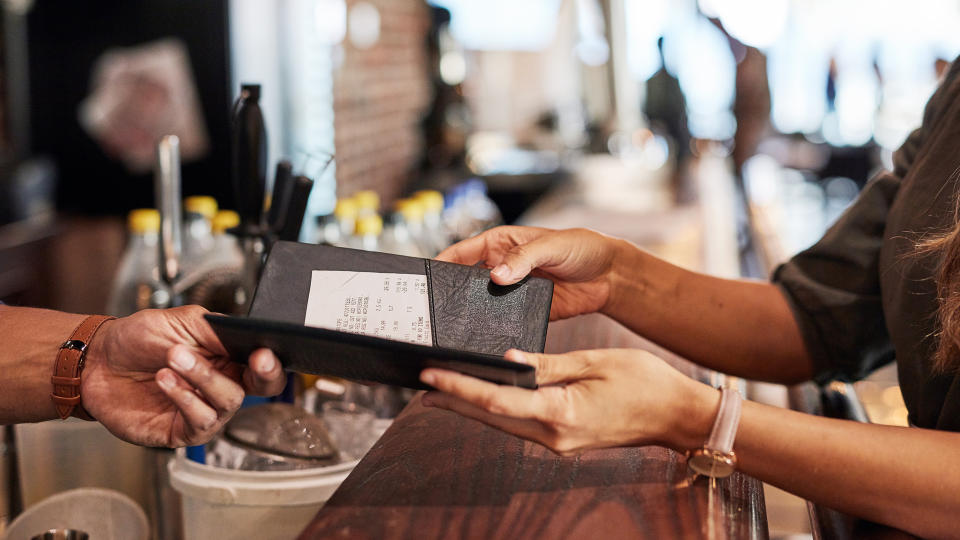Experts: 3 Times To Tip — and 3 Times Not To

Whether you’re dining at a five-star restaurant, lodging at a hotel or getting a haircut, there’s a section on the bill reserved for leaving a gratuity. Tipping practices have changed in recent years, especially since the COVID-19 pandemic when business owners increased tipping recommendations as a way to retain their employees without having to raise prices.
Check Out: Costco Is Raising Prices: 3 Unexpected Items That Will Cost More Money This Year
Up Next: How To Get $340 Per Year in Cash Back on Gas and Other Things You Already Buy
While some consumers are happy to tip more, others feel inflation pressure and don’t want to increase their spending. And most are confused about how to tip these days: when it’s appropriate to leave a tip, how much to tip and when it’s acceptable to decline tipping.
GOBankingRates spoke to two consumer experts on the topic: Amanda Belarmino, hospitality professor and expert on consumer behavior and tourism at the University of Nevada, Las Vegas (UNLV), and Alonso Marly, travel expert at SkyLux Travel, to clear up the confusion about today’s tipping landscape.
1. How COVID-19 Changed Tipping Practices
We’ve seen a big change in tipping practices since COVID. Some establishments that traditionally relied on having a tip jar provided the option to tip by credit card because people weren’t spending cash.
As it became difficult to attract and keep employees and the country was hit by high inflation, more places have added tips as a way to reward and maintain their employees, said Belarmino. But many customers feel that tipping has become a burden and the term ‘tipflation’ was born, as CBS News explained.
Consumers are feeling overwhelmed by tipping pressures, even from advertisers. “We see things like Domino’s advertising that if you tip their driver, they’ll give you a $3 coupon off your next pizza,” said Belarmino.
Spend Less: 5 Expensive Costco Items To Buy Online on Amazon Instead
How Much Should You Tip?
Bellarmino noted that tipping practices in the U.S. have changed in the last 10 years from the standard tip being 15% to between 18% and 20%.
“Today, 15% to 18% is perfectly reasonable,” she said. “A 20% tip should be [reserved for] someone who did something exceptional for you, [in] my opinion. When [someone does something] out of the ordinary or someone has gone out of their way, then that would be appropriate.”
Belarmino thinks the UberEats suggested tip as 21% is too high. “I mean it’s delivery, they’re not making the food; I’m not even going to talk to them,” she said.
When Is It Acceptable Not To Tip?
According to Belarmino, it’s appropriate to continue to tip in full-service restaurants where a server waits on you and perhaps even in a coffee shop where they prepare the coffee. But at other times it’s fine to forgo a tip.
Belarmino recalled grabbing a bottle of water at a coffee shop and feeling expected to tip. She thought to herself, “Well, you didn’t do anything; I grabbed the water out of the fridge, you rang it up. I’m not tipping you under those circumstances.”
She said, “It’s still up to the consumer’s judgment to decide when to tip. If you’re given an iPad with the option of ‘no,’ just go about your business.”
According to Belarmino there isn’t anything wrong with that, especially in circumstances when the person isn’t doing anything that would warrant a tip.
“[For services] such hairdressers and manicurists, where tipping [has always been customary], I would continue to tip, especially for your hair,” she said.
Marly added when it comes to situations where it’s acceptable not to tip, the first one on the list is when you’re simply not satisfied with the service. “The same goes for establishments where the tip is already included in the price or restaurants with a ‘no-tipping’ policy.”
When traveling, it’s always best to research the tipping culture of the destination you’re visiting by doing a quick online search. “There are countries like Japan, where tipping is, in fact, frowned upon,” Marly said. “Keep in mind that all around Asia, tipping culture is not common in general and the tip will either already be included in the bill or simply refused.”
Final Tips on Tipping
“Suggested tips are often higher than what customers typically leave,” said Belarmino. In these situations, even when an lower tipping percentage is not available, you can select the manual write-in option to include a tip of your choice.
“It’s acceptable not to tip in circumstances where you wouldn’t have tipped pre-COVID; if you don’t normally tip at a fast-food restaurant, then it would not be expected to do it now,” said Belarmino.
“Customers should never feel obligated to tip unless they want to, or the staff has provided excellent service,” Marly said.
Always read the receipt to see if your tip is included in the bill.
More From GOBankingRates
I've Secretly Put Us in Serious Debt: How To Break the News to Your Spouse
This is The Single Most Overlooked Tool for Becoming Debt-Free
This article originally appeared on GOBankingRates.com: Experts: 3 Times To Tip — and 3 Times Not To

 Yahoo Finance
Yahoo Finance 